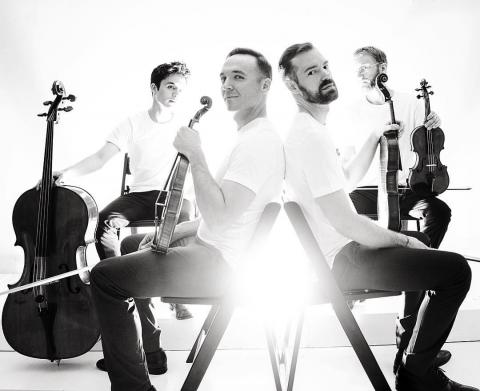The Seagull Effect: Finding New Sounds with the JACK Quartet

The JACK Quartet
Image courtesy of the artist
Hearing Your Imagination
Suppose you have an idea for a string quartet piece about the beach. You want the players to make their instruments sound like waves, like songbirds, like seagulls. You can hear all these sounds clearly in your imagination, and you can try to score your instructions clearly. But until you hear the piece performed, there’s no way to be sure what you’ve imagined will match up to the sounds the ensemble will make.
This is a key reason why reading sessions like the ones conducted during the JACK Quartet’s fall residency at Berklee, hosted by the Professional Writing and Music Technology Division, are so crucial for student composers. In these sessions the world-class new music ensemble provided an invaluable opportunity for Berklee students to hear their score interpreted by professional musicians, and to receive practical feedback on how those musical ideas translate from the mind to the page and into the performer’s hands.
An Informal Rigor
It’s a Tuesday morning. The renowned string ensemble arrives dressed in jeans, t-shirts, sneakers, and hooded sweatshirts. A passerby would never guess that this group has played in venues like Carnegie Hall and Lincoln Center and collaborated with some of classical music’s most innovative composers—among them Pulitzer Prize winners Steve Reich, John Luther Adams, and Caroline Shaw—or that this same week the group was named Ensemble of the Year by Musical America.
An engineer sets up the microphone in the center of their half-circle of seats, and the quartet improvises a wonderfully discordant crescendo of a soundcheck, stopping in unison a few seconds later. Some students may go on to use today’s recordings for graduate school applications or for festival submissions, in addition to their use in future review and refinement of their compositions.
Throughout this reading session, the quartet and the composers work toward the clearest possible communication of sometimes lofty musical ideas. For a particularly wavering and harmonically complex passage in one piece, the players advise the composer to write the intriguing direction, “sul tasto [played with the bow over the fingerboard], veiled and unstable.” Once they’ve agreed upon new directions, the musicians can edit the score on their tablets in real time.
In other cases their advice aims to make a piece as easy as possible for the performer to read. For example, they impress upon each composer in the room the importance of “beaming” rests—a way of writing pauses that allows the performer to see more immediately how the rest fits rhythmically into its measure.
Playing the Ocean
With nearly every piece the quartet plays, something magical occurs during the conversation after the initial read-through. Another student composer’s piece, called “Beach Scenes,” conjures a coastal soundscape using an array of unconventional playing techniques. Through some sections, the players drag their bows across muted strings to imitate the hush and hiss of waves. Other passages recall the call-and-response of birdsong. But some of the notations strike the musicians as a bit vague.
“Be more specific about the distortions of sound,” the quartet’s cellist, Jay Campbell, advises after they’ve played through the piece. He returns to the score, to a particular phrase that they’ve come to refer to as the “seagull effect,” and he plays through several possible variations on the technique the moment calls for. Then comes the thrilling moment when he finds the exact sound, and everybody in the room hears the seagulls calling after one another. “That’s it!” the student composer says.
Finally, through some technical back-and-forth, they manage to solve the other half of the compositional riddle: how to turn this very precise effect into musical notation. And now that the moment is set on the page, it’s ready to come alive again in another player’s hands.



